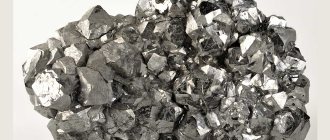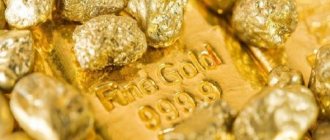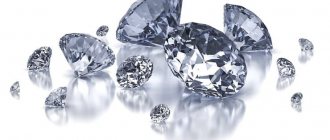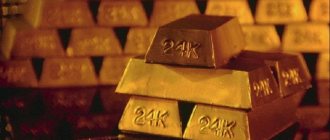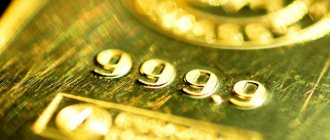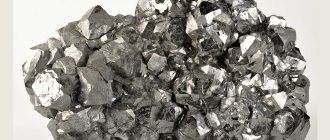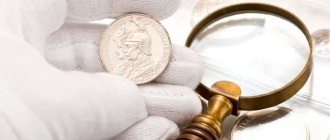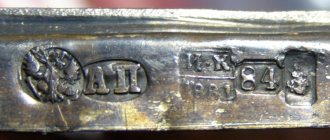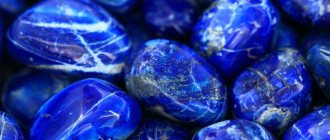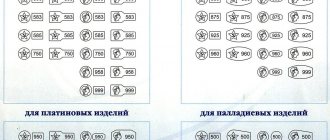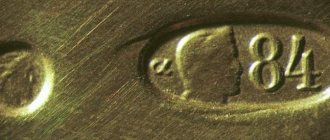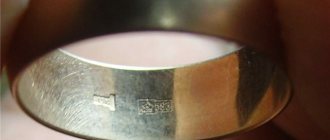Silver hallmarks are markings on a precious metal that indicate the purity of the alloy. Different countries used their own marking systems, but the masters had one goal - to show the buyer the quality of their creation. Pure silver has never been used in production - the metal is too soft and not suitable for dishes and jewelry.
Silver hallmarks often consist of combinations and numbers that craftsmen have used to mark their pieces for hundreds of years. Numerical marks indicating the percentage of pure silver in the material are common. The marking was unified in the states that signed the Convention on Control and Labeling.
Types and shades of silver
Due to its low hardness, silver without additives is not used for the production of jewelry and cutlery. Objects made of pure metal cannot withstand mechanical stress. This means that the composition must include a ligature. It is the introduction of additives that affects the color of the finished product.
There is another factor that determines what shade the jewelry will be. It's about coverage. Ag often looks different when applied to other materials. Existing types of silver:
- matte: obtained as a result of the use of matting technology, the desired result is achieved through the use of a stamp, vibroengraver or sandblasting unit, the products acquire a dull silver tint;
- oxidized: when metal is immersed in a sulfur-containing solution, a dark coating is formed on the surface, the purpose of using this metal finishing technique is to increase decorative qualities; with the help of oxidation, the pattern can be emphasized;
- blackened: the product is painted using a black alloy based on silver, lead, sulfur and copper; to increase the strength of the coating, the method of making notches is used; the dark metal is fused in these areas to a depth of 0.3 mm;
- gold-plated: externally, jewelry is difficult to distinguish from true gold, because they are covered with the same metal, the layer thickness is 1-2 microns, the shade of silver products is yellow, the coating is applied using the electroplating method.
Silver bracelets
A little about this test
750 standard is popular among jewelers and their clients. This is the most successful combination of the purity of a noble metal and ease of use: 999 standard is too soft to be worn constantly. However, a gold content of 75% is sufficient for the product to retain the inherent luster of pure gold.
Composition and properties
As can be understood from the name of the sample, 25% of the mass of our pendant or chain is made up of ligature (foreign metals). Impurities are added to gold primarily because the pure precious metal is extremely sensitive to damage. The 999.9 fine bank bullion can be scratched with a fingernail. This is unacceptable for jewelry that we wear on our bodies, so a ligature is added to gold to increase its wear resistance.
750 gold is common and contains the following additives in different proportions:
- copper (the main alloying component of most alloys);
- silver (also present almost everywhere);
- palladium (added to white gold);
- platinum (rare);
- nickel (rare).
Strength
The price to pay for the prestige of a high-grade alloy and its characteristic shine is the need to wear it carefully. 18K jewelry is easier to break than low-grade analogues.
Alloy shade chart
To understand what shade the alloy will give to gold, you need to look at the original color of the alloying metal. Often there are several additives. Let's look at the popular options for metal “cocktails”:
| Try | Color | Gold | Silver | Copper | Palladium |
| 18 carat | red | 75 % | 40 % | 21 % | No |
| 18 carat | pink | 75 % | 12,5 % | 12,5 % | No |
| 18 carat | yellow | 75 % | 17 % | 8 % | No |
| 18 carat | greenish | 75 % | 25 % | No | No |
| 18 carat | white | 75 % | 5 % | No | 20 % |
Brand
In addition to the hallmark, each piece of jewelry must have an imprint of the name of the manufacturer. The name plate is registered by a branch of the Assay Chamber under the Ministry of Finance of the Russian Federation and contains encrypted information about the year of manufacture of the jewelry and the factory.
Properties of silver as a noble metal. System for assessing silver purity in Russia
Silver belongs to the 5th period of the periodic table (number 47). It is designated by the letters – Ag. The name of the metal in Latin is Agrentum. In its pure form it is distinguished by its white color. In addition, Ag is a soft metal. It is inferior in this parameter to lead, but superior to gold. Other properties:
- high plasticity;
- the highest reflectance coefficient is close to 100%, which makes silver the best in the production of mirrors and other reflective surfaces;
- the highest degree of thermal conductivity – Ag surpasses all other metals in this parameter;
- limiting value of electrical conductivity.
In its pure form, Ag is superior to other metals in many respects, but in the production of jewelry and other products they are of little importance; in this case, wear resistance and hardness play a role, which is provided by additives. To control the composition of precious metals in Russia, the metric system is used.
Carat
More often used in Europe, USA, Canada. Gradually, in some countries (for example, in England), the metric system was introduced, which is why double branding on products is still common. The amount of Ag in the alloy is determined using a given value - 24 carats. This is a sample of pure metal. Its value decreases as the proportion of Ag decreases.
Formula for converting metric standards to the carat system
Many people ask the question of how to independently convert a metric sample into a carat sample and vice versa. There is a special formula for this that greatly simplifies the task.
So, this ratio looks like this: 24: 1000 = X: Y, where Y is metric. X - carat.
In order to calculate how many carats a sample represents, you must follow the formula X = 24 * Y: 1000. For example, 585 according to the formula X = 24 * 585: 1000 is 14 carats.
Conversely, metric is calculated as: Y = 1000 * X: 24.
10 carat gold is the most common in the USA; what standard it corresponds to in our country can be easily calculated using the same formula. So, 10 Carat is Y = 1000 * 10: 24 = 416.
Thus, 10 carat gold corresponds to 416 standard, but we do not produce such products.
Correlation of gold samples in different systems.
It is easy to calculate the remaining samples:
- 100% alloy is 24 Karat, which corresponds to 999 fineness;
- 75% of the yellow metal in the alloy is 18 Karat, which is identical to the 750 standard;
- 58.5% in the alloy - 14 Karat and equal to 585;
- 50% in the alloy is 12 Karat and, accordingly, 500 standard;
- 37.5% in the alloy is 9 Carats and, accordingly, 375;
- 33.3% in the alloy is 8 carats and 333 in the metric system.
24 and 18 karat gold belongs to the high-grade group, 12 and 14K jewelry belongs to the middle group, 8 and 9 karat gold belongs to the low-grade group.
Color options for rings of various samples.
A higher percentage of precious metal (or carat value) in jewelry makes it appear more vibrant in color and increases the price.
Characteristic properties of basic silver samples
There are a large number of types of brands, their values range from 600-999. They correspond to the amount of pure silver; the sample does not determine the proportion of impurities, but it can be calculated independently. For example, products 925 contain 925 parts by weight of Ag, as well as 75 parts by weight of alloys. Copper, nickel, cadmium, iron, and antimony are used as additives. But most often silver is combined with Cu. Each silver sample has its own characteristics:
- 800: contains a fairly large proportion of precious metal (80%), the rest consists of impurities, the alloy is rarely used in Russia, its main area of application is the production of souvenirs, cutlery and dishes used in everyday life (containers for spices, drinks), much it is more common in Germany, however, metal of 800 standard is considered low-grade, but still 800 is the minimum acceptable proportion of Ag;
- 830: the quality of the alloy is slightly higher than that of the previously considered option, the share of Ag is 83%, but still such a metal is rare, it is usually used for the production of cutlery and souvenirs;
- 875: such a mark is found on old-style silver products, for example, in the USSR, the hallmark was the gold standard in the production of table silver - 84 (marking according to the spool system), today such products are bought in antique stores, the hallmark is found only on antique items;
- 925: this type of mark is most often found on silver products, but they are more expensive, but they are in good standing with consumers due to their quality (they contain 925 parts by weight of Ag), this variety is considered the most suitable for the production of jewelry, it is ranked one level in the rating with alloy 875, but the latter is practically no longer used;
- 960: the metal is more valuable, considered the best due to its high Ag content (96%), but the alloy has a significant drawback - increased softness, on the one hand, this allows you to give any shape to the product, on the other hand, finished jewelry is easily deformed, so 960 silver is used in the production of rings, bracelets, chains, but as additional elements;
- 999: the highest standard, contains the maximum amount of Ag (999 parts by weight), only 1 part is due to impurities, when deciphering the numerical value of the mark, this 1% is usually not put, the alloy is conventionally considered pure, and the minimum amount of additives is attributed to natural impurities, but this a mark on silver indicates that the metal cannot be used for the production of products; it is used only in the manufacture of ingots.
Price
18 carat gold has been found, now it remains to decide how much the product will cost. The final cost includes not only the carat value, but also the weight of the item, the complexity of its manufacture and the design performed. The main mistake of many buyers is that when determining the price, they focus on how many grams of gold are in the item. This is not the main indicator. The work done greatly influences the final cost.
Each manufacturer has its own methods to make the product more flexible and durable. Of course, the price greatly depends on the quality.
Inset gemstones, special clasps and small details also affect the cost.
Most gold items are made automatically. But sometimes a piece of jewelry needs expert manual processing or engraving. The cost of such an item is rising. The market price of one gram of 18-karat gold ranges from 4800-5000 rubles.
Summary table: what types of silver are there, their % composition, scope of application
There are a large number of hallmarks that are used to designate silver products, some are no longer in use, while others, on the contrary, are used more often than others, because they are better in composition and properties. You can determine which option is more suitable by comparing. The most common silver samples in the table:
| Try | Composition – proportion of Ag, % | Application area |
| 720 | 72 | Cheap jewelry made from low-quality alloy, the main difference is the yellowish tint |
| 750 | 75 | The metal is low grade, but contains more Ag than alloy 720, and therefore its scope is somewhat wider. Despite the fact that it is one of the last steps in the ranking of silver-based materials, it is used for the production of cutlery and dishes |
| 800 | 80 | Making kitchen utensils |
| 830 | 83 | The scope is the same as for other low-grade alloys: production of dishes, cutlery |
| 925 | 92,5 | Used for the manufacture of jewelry, structural elements, coatings, coins, memorial signs (for example, a cup is produced) |
| 960 | 96 | They create jewelry, accessories, decorative elements, but due to its softness the metal cannot be used for the production of elements in areas of high responsibility (where there is a significant load) |
| 999 | 99,9 | Bank metal (ingots, coins) |
Products made from alloy 600 are not popular in Russia, but such metal is found in European countries, but the silver hallmark option is 800, which is considered the minimum acceptable.
Exactly how much gold is in jewelry made from metal of various samples
For those who don’t really want to bother with calculations, the information below is suitable.
As noted at the beginning of the article, our highest standard is 999. Its analogue in the karat system is 24 k. In both cases, it is assumed that the alloy is 99.9 percent pure precious metal.
Besides:
- 18 k, we have also already found out, is equal to the 750th sample, or 75% gold;
- 14 k is, accordingly, the 580th sample, or 58.5%;
- 12 k – 500th and 50%.
- 9 k – 375th and 37.5%;
- 8 k – 333rd and 33.3%.
Elements of silver markings on jewelry. Testing control. Brand
According to Russian legislation, products containing 80% Ag or more are subject to testing. Due to the softness of application, the only possible option is laser engraving. Having figured out what types of silver there are, you need to understand what the mark looks like in order to distinguish it from a fake. Main marking elements:
- a sign symbolizing a state ID;
- directly a sample that determines the amount of precious metal;
- the code of the inspectorate under whose supervision the assay was carried out contains a letter (each of the 18 such organizations has its own symbol, thanks to which it became possible to recognize the assay district).
The cost of 1 gram of pure silver: how the price is fixed
Price changes occur daily. However, one of the values is fixed, and this happens twice a day. The price of silver on the Russian market depends not only on the Central Bank of the Russian Federation. The price set by the main international exchange in London also has an impact. The cost of fixing is the main guideline for market participants.
Formula and results for calculating the cost of the corresponding sample
You can find out the price of silver without going to reputable sources. To do this you will need the cost of 1 g of pure metal. This number is multiplied by the value corresponding to the Ag content in the alloy, examples for different samples:
- 800: 65.56*0.8=52.45 rub.;
- 830: 65.56*0.83=54.42 rub.;
- 875: 65.56*0.875=57.34 rub.;
- 925: 65.56*0.925=60.65 rub.;
- 960: 65.56*0.96=62.94 rub.
The cost at Sberbank and others may differ from the Central Bank rate. This is due not only to the composition of the metal, but also to the organization’s policies.
Ring 985 sterling silver
Factors influencing consumer value
The cost of the highest standard metal silver and alloys based on it depends on several factors. The determining factor is:
- cost of raw materials;
- Exchange Rates;
- the cost of currencies and precious metals of the Central Banks of other countries;
- the total amount of raw materials not only in the Russian Federation, but throughout the world;
- degree of demand for metal.
According to experts, the development of existing deposits will be completed in 2 decades, then there will be a sharp jump in the growth of Ag prices.
International silver standards
- 1000 is the standard used in Japan. The purest sample in the world.
- 980 – in Mexico.
- 970 – in Mexico.
- 959 – in the Czechoslovak Republic and the Czech Republic.
- 950 - in Great Britain, France, Japan, USA, the Netherlands (used until 1814), Switzerland, Yugoslavia, Bulgaria, Romania, Hungary.
- 940 – in Mexico and Poland.
- 935 – in Austria, Germany and Switzerland.
- 934 – in the Netherlands (until 1953).
- 930 – in the Netherlands, Germany, Israel, Palestine.
- 925 - in Great Britain (Sterling), USA (Sterling - since 1870), Ireland - (Sterling), Denmark (since 1893), Israel. Current international standard.
- 916 – in Finland, Poland (after 1963), Portugal (after 1886), Russia (88 Zolotniki), Romania and Spain (before 1934), Latvia.
- 915 – in Spain (until 1934).
- 900 - in the USA (coin - before 1870), China, Argentina, Germany, Switzerland, Italy, Yugoslavia, Czechoslovakia, Hungary, Japan, Egypt, Turkey and Lebanon.
- 875 – in Russia (84 Zolotniki), the Baltic countries, Poland, Finland, Switzerland, Romania, Latvia.
- 844 – in Denmark and Norway.
- 840 – in Iran.
- 835 - operated in the territories of Germany, the Netherlands, Belgium, Austria and Portugal.
- 833 in Portugal (after 1886), the Netherlands (before 1953), Denmark (after 1800) and Norway.
- 830 - in Norway (after 1892), Denmark (after 1972), as well as in Finland, Sweden and Portugal.
- 826 – in Denmark (from 1893 to 1972), in Norway (until 1892).
- 813 – in Germany, Finland.
- 800 – was popular in the countries of the current European Union until 1814.
- 750 – in Germany and Prussia, in Italy, Yugoslavia, Czechoslovakia, Bulgaria, Poland, Hungary and Romania
- 700 – in the state of Lebanon.
- 687 – in Germany.
- 625 – in Germany.
- 600 – in Egypt.
All of the above data on silver samples were used by jewelers from different countries in different time periods. From the presented list, some values are valid in our time and differ from each other in the international system of standards.
Methods for detecting counterfeit silver
You should not always trust the engraving on a product. All silver samples can be tested for authenticity, but the result depends on the composition of the metal. You can understand what this or that sign means; you should learn more about the use of testing techniques:
- needle: not the most reliable method, to implement it it is enough to make 1-2 scratches on the metal, if at depth the color of the alloy is different (yellow, red), it is not silver, but scammers can also use metals of a similar shade;
- nitric acid: when applying nitric acid to scratches previously made with a needle, you can see a black tint, if there are no additives (the metal is indicated by the purity 999), when there is a ligature, but there is little of it (925), the color should be white, a green tint may mean that the metal contains too much copper;
- lapis pencil: usually put a dot or a stripe, the fake will darken when applied;
- sulfur ointment: upon contact with sulfur, silver darkens, which means that if the product turns black, it is precious, the fake alloy will remain unchanged or turn green;
- iodine: when applied, the alloy will behave differently (zinc will turn blue), but the fake alloy will not change its appearance;
- hot water: the easiest way to test silver at home, just immerse the product in boiling water for 15 seconds, then remove it, the real metal will be very hot, the fake will be barely warm, which is due to the high thermal conductivity of Ag;
- magnet: bringing the magnet 10-15 mm closer to the product allows you to understand whether the entire item is made properly - from silver, this applies mainly to chains, sometimes manufacturers replace some of the links with simple materials, so it is recommended to check the product along its entire length, also evaluating the external quality of weaving, while Ag will not react to the magnet.
How to determine the product sample yourself
If there are no identification marks on the product (this happens after repairs, if the product is antique, or when importing foreign jewelry), you can determine on your own how much silver the item contains. A simple method is based on a sample testing reagent (“Chrompik”). Instructions:
- They make a scratch.
- The substance is applied.
- Wait 5-10 minutes. If a red color appears, most likely the product is of the highest standard, a darker shade of red is 925, brown is 800, green is less than 800.
How to choose the right silver product
Pay attention to color and weight: Ag is a fairly heavy metal, white. The more copper, the closer the shade to red. In addition, 925 grade jewelry reacts less well to magnets than jewelry with a lower Ag content. Silver plated jewelry will be marked "MET".
Silver jewelry
Difference between 14 and 18 carats
18K is considered an elite grade. 14K (585 standard) is worn mainly as an everyday option, saving the expensive 750 standard for special occasions.
Cleanliness, hardness and durability
The more alloys in the alloy, the more pronounced the properties of the alloying components. 585 sample, consisting of almost half of impurities, is much lighter, harder and stronger than 750 sample, and is less susceptible to minor damage such as scratches or dents.
The color of pure gold is bright yellow. An alloy containing a lot of copper takes on a reddish tint (pure copper has a rich brick-pink color). Green gold is coming into fashion, which contains no copper at all, but a lot of silver.
Many jewelers use the rhodium plating technique in their work - coating products with a thin (1.5–25 microns) layer of rhodium (a rare platinum group metal, many times harder than gold). Rhodium-plated jewelry can be not only the classic yellow, pink and white colors, but also black.
Markings
¾ gold items are marked o (units of measurement are indicated after the numbers). In Europe, such a ring will most likely have two marks at once: carat and metric (750).
Price
In Arab countries, you can find jewelry positioned by sellers as almost pure gold, but the reliability of these assurances is questionable.
Question-answer section
What type of silver is the best and most expensive?
Expert opinion
Grishanov Mikhail Petrovich
Jeweler, director of the Grishanov and Co. workshop
It is necessary to take into account the purpose that is set during the assessment. If jewelry is considered, 925 products are the best; they are more durable and contain a significant proportion of silver. However, for investments, products with even higher content are being studied - 960 and 999, the latter of the options is not used for the production of jewelry, it is bank metal.
Table silver, how to understand the sample?
Expert opinion
Pribrezhny Gennady Valentinovich
Jeweler 6th category
The fineness of a silver product is indicated. If we are talking about cutlery that is made from other metals, but coated with a layer of Ag, then indicate the type of material: AL (aluminum), STAINLESS (steel), MN (nickel silver), etc.
How to determine the silver sample at home?
Expert opinion
Andrey Seleznev
Chemist-technologist, Volgograd
It is recommended to use special reagents. They are available for sale, you should ask in special stores and jewelry workshops. It is enough to apply such a substance to the product; the sample and alloy are determined by the color change. But there must be a scratch for the reagent to enter the structure of the material.
What is the highest grade of precious metal?
Expert opinion
Grishanov Mikhail Petrovich
Jeweler, director of the Grishanov and Co. workshop
The highest measure is 999. The metal is conventionally called pure, but it contains a small proportion of impurities: 0.01...0.1%. Theoretically, it is difficult to obtain silver without additives, which is why alloy 999 is called “highest sterling.”
Silver bars
What types of antique silver are there?
Expert opinion
Pribrezhny Gennady Valentinovich
Jeweler 6th category
In ancient times, there was no unified system for marking precious metals, so each master/manufacturer used his own mark:
Simulant metals
To reduce the cost of products, as well as to make them more similar to silver, materials were used containing durable components, but without precious metals:
- cupronickel (MN) - most often copper and nickel were used for production, less often zinc, manganese or iron were added, this material is more reminiscent of Ag than others, due to the color - also white, but cupronickel is harder;
- nickel silver (MNC) - the metal was called the new silver, contains copper, nickel and zinc, the result of this combination is the production of an alloy that does not differ in appearance and properties from cupronickel, but its production is cheaper;
- aluminum (AL) is a cast aluminum alloy containing various metals;
- stainless steel (STAINLESS) is another analogue of silver, but in appearance it is more different from the precious metal.
Jeweler's comment
Molokanov N.M.
Jeweler, 26 years of experience in jewelry production.
To determine the standard of gold, I would advise you to immediately go to a jewelry master, since this requires experience and knowledge. At home, people see the color that has changed during application, but do not know that it is also affected by the internal component of the alloy. In this case, even a small fraction of the component plays a role. If you mistakenly determine the composition of the metal, nothing bad will happen. But the person who was going to sell it may be disappointed when it turns out that what was disguised as silver was not a precious alloy, but a fake.
